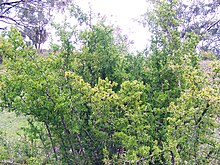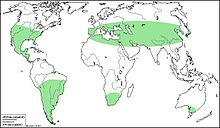| Lycium | |
|---|---|

| |
| African boxthorn (Lycium ferocissimum) | |
| Scientific classification | |
| Kingdom: | Plantae |
| Clade: | Tracheophytes |
| Clade: | Angiosperms |
| Clade: | Eudicots |
| Clade: | Asterids |
| Order: | Solanales |
| Family: | Solanaceae |
| Tribe: | Lycieae |
| Genus: | Lycium L. (1753)[1] |
| Species[2] | |
|
101; see text | |

| |
| Synonyms[2] | |
| |
Lycium is a genus of flowering plants in the nightshade family, Solanaceae.[3] The genus has a disjunct distribution around the globe, with species occurring on most continents in temperate and subtropical regions. South America has the most species, followed by North America and southern Africa. There are several scattered across Europe and Asia, and one is native to Australia.[4] Common English names for plants of this genus include box-thorn,[5] wolfberry, and desert-thorn.[6] Plants of the World Online currently accepts 101 species.[2] Other estimates are of 70[4] to 80[7][8] species.
- ^ "Genus: Lycium L." Germplasm Resources Information Network. United States Department of Agriculture. 2009-09-01. Retrieved 2010-12-13.
- ^ a b c Lycium L. Plants of the World Online. Retrieved 24 April 2024.
- ^ "Genus Lycium". Taxonomy. UniProt. Retrieved 2009-04-16.
- ^ a b Fukuda, T., et al. (2001). Phylogeny and biogeography of the genus Lycium (Solanaceae): Inferences from chloroplast DNA sequences. Archived 2003-11-30 at the Wayback Machine Molecular Phylogenetics and Evolution 19(2), 246-58.
- ^ Lycium. The Jepson eFlora 2013.
- ^ "Lycium". Integrated Taxonomic Information System.
- ^ Lycium. Flora of China.
- ^ Levin, R. A. and J. S. Miller. (2005). Relationships within tribe Lycieae (Solanaceae): paraphyly of Lycium and multiple origins of gender dimorphism. American Journal of Botany 92(12), 2044-53.